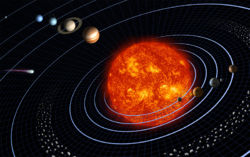Solar System
 From Conservapedia
From Conservapedia According to the scientific consensus, the Solar System consists of the Sun and the astronomical objects gravitationally bound in orbit around it. Some scientists claim that the Solar System was formed from the collapse of a giant "molecular cloud" approximately 4.6 billion years ago. Creation scientists reject this and argue it was created by God around 4,000 BC.
Contents
Planets[edit]
According to the 2006 definition, a planet is an object that orbits the sun, is massive enough that its own gravity pulls it into a nearly round shape, and is dominant enough to clear away objects in its vicinity.[1] According to that definition, there are eight planets in the solar system. They are, in order of increasing distance from the sun:
The first four planets are terrestrial planets, the last four planets are Jovian planets. Terrestrial planets are small in size, have high densities, and consist of rocky materials. Jovian planets are large in size, have low densities, and consist of gaseous materials. In some cases, Uranus and Neptune are known as ice giants due to the large presence of gases they have, heavier than hydrogen and helium.
Since 2016, a ninth planet or even several trans-Neptunian planets are being considered likely.
Dwarf planets[edit]
A dwarf planet is an object that orbits the sun and has a round shape and was defined in 2006. The crucial difference between a planet and a dwarf planet is that a dwarf planet is not large enough to clear the neighborhood of its orbit. Currently recognized dwarf planets are:[2]
Note[edit]
[1]–Pluto was considered a planet until 2006.[3]
Asteroids[edit]
Asteroids are irregularly shaped chunks of rocks in the solar system. They exist mostly in 3 places:
- The asteroid belt, which is between the orbits of Mars and Jupiter
- The Kuiper belt, which shares its orbit with Pluto
- The Oort cloud, which is far beyond the Kuiper belt
Comets[edit]
Comets are astral bodies composed of dust and ice. As they approach the sun the increased temperature causes them to heat and shoot off jets of material, forming a "tail" pointing straight towards the sun. Most comets are in circular orbits out in the Oort cloud beyond Pluto. Some are in an elliptical orbit around the sun, meaning that they will repeatedly enter orbits near the sun until they have evaporated. Some are in a hyperbolic orbit around the sun, meaning that they will only come into the solar system once and will never return, moving on to other solar systems until they have evaporated or are captured in an elliptical orbit.
Scientific dating[edit]
The closest material we have to hand, rocks formed in Earth's crust, has been subject to chemical alteration over time from volcanic action, so for accurate dating scientists use meteorites which have been free flying for billions of years before entering our atmosphere. Mass spectrometers are used to accurately identify and measure the different atomic isotopes making up a core sample from a meteorite. Different radiometric dating techniques from the same sample are used as a guard against possible contamination. The isotopic ratios of the sample correspond to the degree of atomic decay, accurately measuring the sample's age.
External links[edit]
See also[edit]
References[edit]
- ↑ https://www.nasa.gov/vision/universe/solarsystem/planetsf-20060824.html
- ↑ http://www.answers.com/topic/dwarf-planet
- ↑ http://www.thenewstribune.com/soundlife/story/261408.html
| |||||||||||||||||||||||||||||
Categories: [Astronomy]
↧ Download as ZWI file | Last modified: 02/09/2023 15:15:52 | 47 views
☰ Source: https://www.conservapedia.com/Solar_System | License: CC BY-SA 3.0
 ZWI signed:
ZWI signed:
 KSF
KSF